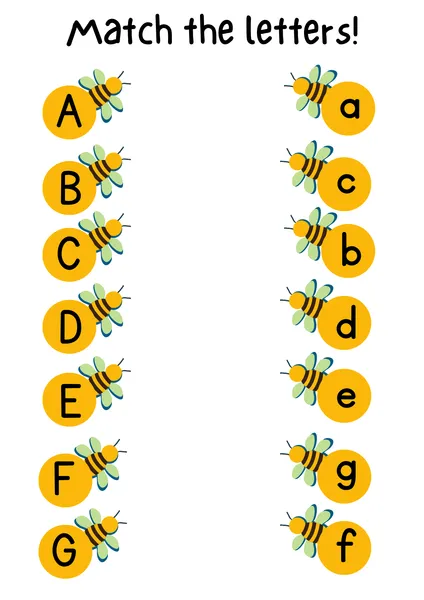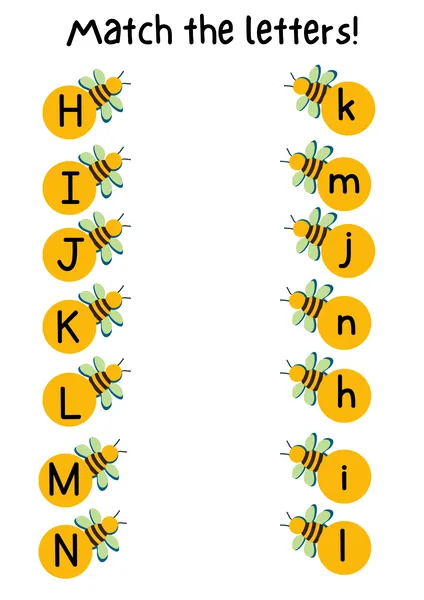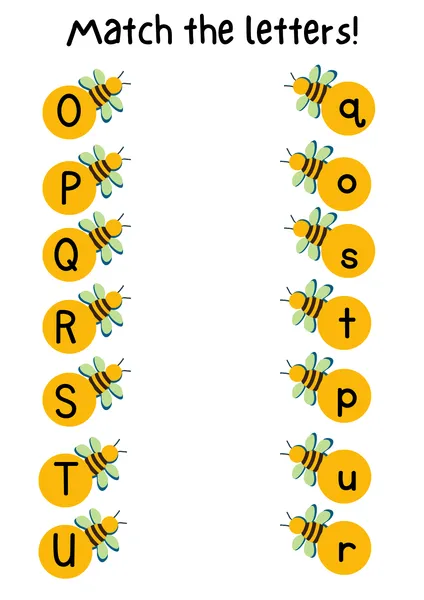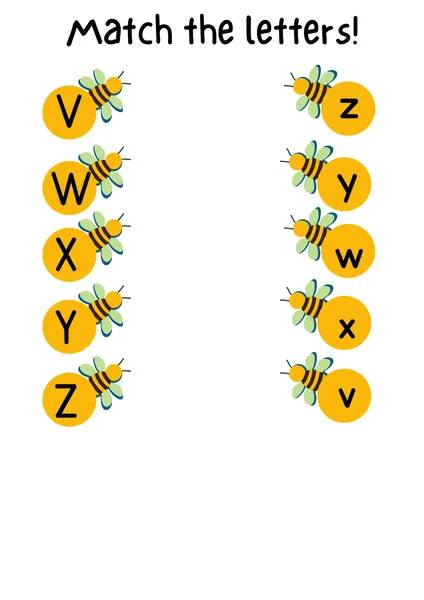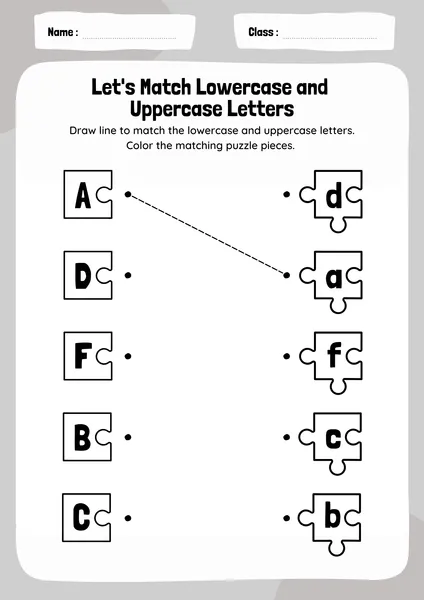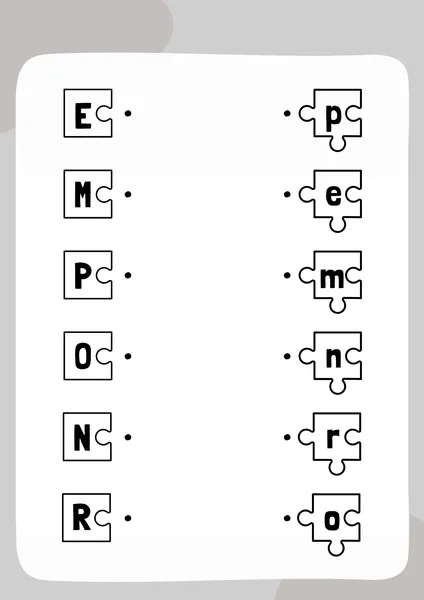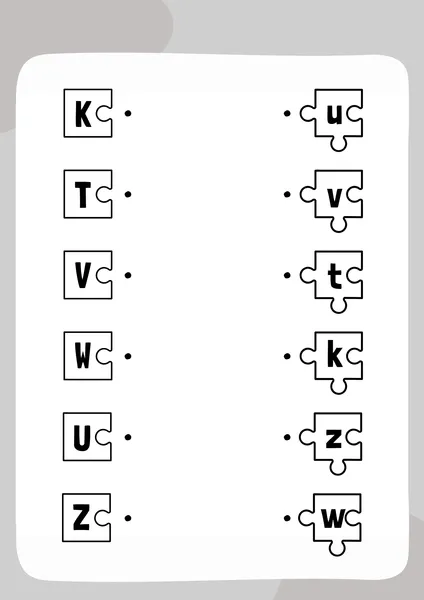Uppercase and lowercase letter matching – It is like learning a new language or a new code that can help you read and write! We like this code because it is interesting to know how the big and small letters are used. They are like the two faces of one medal; they have the same sound but in different dimensions. This article is your step-by-step guide to teaching your child uppercase and lowercase letter matching through engaging activities and free printable worksheets. It’s time to be an alphabet whiz!
Why is Matching Uppercase and Lowercase Letters Important?
Think of it like this: It might have various forms, but it has the same meaning as the other. Here’s why knowing how they match up is super important:
- Become a Reading Rockstar: Recognising both uppercase and lowercase letters becomes easier and faster, and that is when reading becomes more effortless. That is like having an upgrade in your reading experience!
- Writing with Confidence: Matching letters assists you in writing neatly and effectively when it comes to writing a story, a message to a friend, or even your name.
- Crack the Code of Sounds: Matching letters teaches you how to link the letters you are looking at with the sounds they produce. This is like trying to learn the language of words!
- Sharpen Your Detective Skills: Knowing how to tell the two apart is an excellent way to improve your observation skills since you are required to distinguish between the two.
Great Activities for Uppercase and Lowercase Letters Sorting
Are you ready to have some fun while gaining knowledge? Try these cool activities:
Matching Games:
- Memory Match: Think about a game of concentration where the two of each kind are capital and small letters. Move cards and attempt to find the pairs that are the same. It is a mental exercise! To make it even more fun, use pictures or stickers that start with each letter, for example:
- Puzzle Power: Make word searches where each word is formed by an uppercase or lowercase letter. Match the pieces and discover the letter code to open the puzzle! To make your puzzles, you can draw a picture, cut it into pieces, and then write the matching capital and small letters on each piece.
- Bingo Bonanza: Play bingo with a twist! Instead of the numbers, your bingo card will contain the uppercase and lowercase letters. When your letter is being called, listen for it and cross it off on your card. For a challenge, say the letter sound and ask the players to find the capital and small case letters representing that sound.
Letter Detective:
- Letter Hunt: Go on a letter hunt! Lay the letter cards around the room and look for every uppercase and lowercase pair. It is like a letter search game – you must find the letters! To add fun, have them scattered all over the room, under chairs, behind curtains, or even on the ceiling!
- Sorting Squad: Can you arrange a set of letter cards in two categories: the uppercase and the lowercase? It is like planning a lettering party! For a challenge, try to sort them in the least possible time and record yourself.
- I Spy with My Little Eye: Play “I Spy” with letters. Say to your friends: “I spy a lowercase A,” and look for the uppercase A with your friends. Play this game occasionally; you can play it in the classroom, at the park, or even at the grocery store!
Colorful Creations:
- Color by Letter: Color a picture in which different parts are labeled with capital and small letters. Fill in the letter key to the right of the sections to properly color each. It’s like a coloring book! Search for a color-by-letter worksheet to print out or make your own by drawing a picture and dividing it into parts with letters.
- Trace and Color: Now, follow the capital and small letters and color them. This way, you will familiarise yourself with the shapes of the letters and come up with something new.
- Dot-to-Dot Decoder: It is like a password and a riddle simultaneously. You can create your own by drawing a simple picture and then using capital and small letters to replace the numbers in the dotted lines.
Movement and Sensory Fun:
- Alphabet Yoga: Strike a pose! Can you use your body to form different uppercase and lowercase letters? This is a great way to teach kids the letters and have them run around simultaneously.
- Letter Races: Design an obstacle course and put the capital and small case letter cards at various points. Challenge your friend to a race where whoever picks the most matching pairs wins.
- Sensory Bins: To play, pour sand, rice, or beans into a bin and place the uppercase and lowercase letter flashcards in the bin. Sort through the bin to find two of the same, or use your fingers to write letters in the sensory material.
- Building Block Letters: You can use LEGO or wooden blocks to create capital and a small alphabet case. Try to make your letters as big or as small as you want!
Arts and Crafts:
- Letter-Shaped Cookies: Last, put the cookies in pairs, decorate them, and frost and sprinkle the cookies as mentioned above. This is an interesting method for teaching the child the letters!
- Alphabet Puppets: Cut out two paper bags or two socks, write letters on one side, and draw letters on the other. Tell stories or dramatize events with your puppets using various letter sounds.
Free Printable Uppercase and Lowercase Letter Matching Worksheets
Uppercase and Lowercase Letter Matching
Other Great Learning Worksheets
Do you want to learn some more ways to practice? Check out these websites for free printable worksheets:
- Worksheetfun: This website is like a goldmine of free printable worksheets, and plenty of activities help children match up their uppercase and lowercase letters.
- Education.com: Now, it is possible to find a vast list of teaching resources, including excellent printable worksheets for identifying the upper and lower case letters.
- Teachers Pay Teachers: This website is a teacher’s go-to site for finding online resources for teaching, including free and paid printable worksheets for letter-matching activities.
Frequently Asked Questions
- Q: When should a child be expected to match upper and lower case letters?
- A: Although children begin recognizing the letters of the alphabet at the ages of 3-5, it will be helpful to fully understand the relationship between the capital and small letters in grades 1-3 (6-8 years old). But even older kids who require additional drills will find these activities helpful!
- Q: My child struggles to understand which letter is capitalized and which is not. Any tips?
- A: Absolutely! Try these strategies: Visual Aids: A chart of the letters of the alphabet in both capital and small letters to be written on one chart. “Big and Small” Language: When talking about the letters, call the capital letters “big” and the small letters “small.” Hands-on Activities: Your child can make letters using playdough or can make the letters in the sand. Real-World Examples: Name the capital and small letters you see in books, billboards, and your home surroundings.
- Q: Are there any apps or online games that can teach letter matching to kids?
- A: Yes! Many educational applications and websites provide games and activities that help children recognize letters.
Conclusion
In the same way that when we play a game and get to the next level once we solve a puzzle, identifying capital and small letters helps children open the door to reading and writing. These enjoyable activities and printable materials will help you match letters as fast as a flash!
